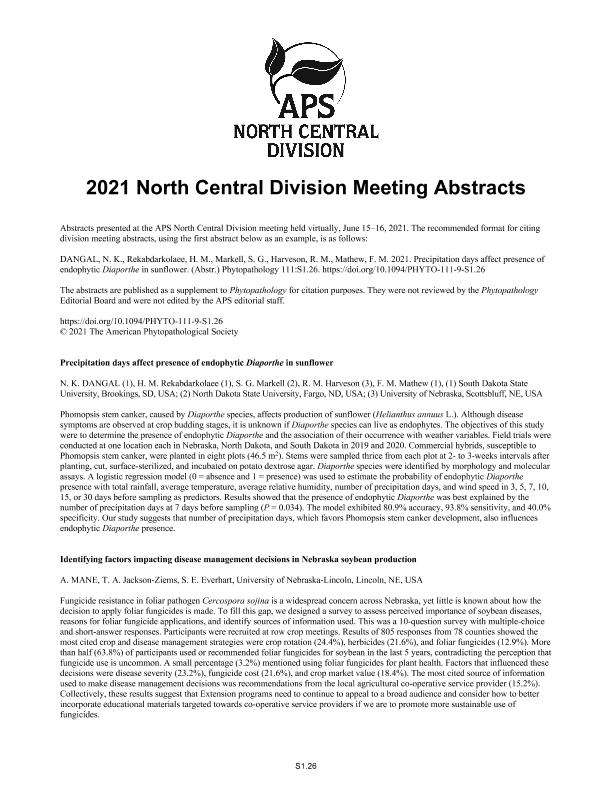Mostrar el registro sencillo del ítem
dc.contributor.author
Martínez, Ana Laura

dc.contributor.author
Garayalde, Antonio Francisco

dc.contributor.author
Quiroz, Facundo José

dc.contributor.author
Carrera, Alicia Delia

dc.date.available
2023-10-19T18:25:32Z
dc.date.issued
2021
dc.identifier.citation
Genetic characterization of Plasmopara halstedii populations in Argentina using simple sequence repeats (SSR) and effectorbased markers; American Phytopathological Society North Central Division Meeting; Iowa; Estados Unidos; 2021; S1.27-S1.27
dc.identifier.issn
0031-949X
dc.identifier.uri
http://hdl.handle.net/11336/215475
dc.description.abstract
Argentina is the fourth leading producing country of sunflower worldwide. Sunflower downy mildew, caused by the pathogenPlasmopara halstedii, is an economically important disease of sunflower. Since 2012, P. halstedii epiphytotics were identified inseveral production regions of Argentina. However, the genetic diversity of the pathogen in Argentina remains largely unknown. Fortytwofield isolates from Argentina were analyzed using eight loci SSR. The number of alleles per locus (APL), the expected (HE) andobserved heterozygosity (HO) were determined. SSR data were analyzed with regions (two), collection years (four) and races (six) asvariation sources (AMOVA), and the population structure was defined (Bayesian method). DNA sequences of two effector genes wereobtained from two isolates per race and the polymorphisms were analyzed (ClustalW). The mean APL was 2.6, varying from 1 to 4(total 21). The highest number of alleles and races were found in 2017. Average HO and HE were 0 and 0.369, respectively. Geneticvariation was observed among regions (7%) and years (32%), but not between races. Based on effectors, local races were similar to agroup of French races, without variation within the ARG races. Increased genetic variability observed in recent years seems to parallelwith the emergence of novel races reducing fungicides and/or R genes efficacy. The effector study suggests that the races evolutiondepends on country specific factors.
dc.format
application/pdf
dc.language.iso
eng
dc.publisher
The American Phytopathological Society
dc.rights
info:eu-repo/semantics/openAccess
dc.rights.uri
https://creativecommons.org/licenses/by-nc-sa/2.5/ar/
dc.subject
plasmopara halstedii
dc.subject
SSR
dc.subject
Genetic characterization
dc.subject
Sunflower
dc.subject.classification
Otras Ciencias Agrícolas

dc.subject.classification
Otras Ciencias Agrícolas

dc.subject.classification
CIENCIAS AGRÍCOLAS

dc.title
Genetic characterization of Plasmopara halstedii populations in Argentina using simple sequence repeats (SSR) and effectorbased markers
dc.type
info:eu-repo/semantics/publishedVersion
dc.type
info:eu-repo/semantics/conferenceObject
dc.type
info:ar-repo/semantics/documento de conferencia
dc.date.updated
2023-02-07T12:56:10Z
dc.identifier.eissn
1943-7684
dc.journal.volume
11
dc.journal.number
9
dc.journal.pagination
S1.27-S1.27
dc.journal.pais
Estados Unidos

dc.journal.ciudad
Iowa
dc.description.fil
Fil: Martínez, Ana Laura. Consejo Nacional de Investigaciones Científicas y Técnicas. Centro Científico Tecnológico Conicet - Bahía Blanca. Centro de Recursos Naturales Renovables de la Zona Semiárida. Universidad Nacional del Sur. Centro de Recursos Naturales Renovables de la Zona Semiárida; Argentina. Universidad Nacional del Sur. Departamento de Agronomía; Argentina. North Dakota State University; Estados Unidos
dc.description.fil
Fil: Garayalde, Antonio Francisco. Universidad Nacional del Sur. Departamento de Matemática; Argentina. Consejo Nacional de Investigaciones Científicas y Técnicas. Centro Científico Tecnológico Conicet - Bahía Blanca. Centro de Recursos Naturales Renovables de la Zona Semiárida. Universidad Nacional del Sur. Centro de Recursos Naturales Renovables de la Zona Semiárida; Argentina
dc.description.fil
Fil: Quiroz, Facundo José. Instituto Nacional de Tecnología Agropecuaria; Argentina
dc.description.fil
Fil: Carrera, Alicia Delia. Universidad Nacional del Sur. Departamento de Agronomía; Argentina. Consejo Nacional de Investigaciones Científicas y Técnicas. Centro Científico Tecnológico Conicet - Bahía Blanca. Centro de Recursos Naturales Renovables de la Zona Semiárida. Universidad Nacional del Sur. Centro de Recursos Naturales Renovables de la Zona Semiárida; Argentina
dc.relation.alternativeid
info:eu-repo/semantics/altIdentifier/doi/https://doi.org/10.1094/PHYTO-111-9-S1.26
dc.relation.alternativeid
info:eu-repo/semantics/altIdentifier/url/https://apsjournals.apsnet.org/doi/10.1094/PHYTO-111-9-S1.26
dc.conicet.rol
Autor

dc.conicet.rol
Autor

dc.conicet.rol
Autor

dc.conicet.rol
Autor

dc.coverage
Internacional
dc.type.subtype
Congreso
dc.description.nombreEvento
American Phytopathological Society North Central Division Meeting
dc.date.evento
2021-06-15
dc.description.ciudadEvento
Iowa
dc.description.paisEvento
Estados Unidos

dc.type.publicacion
Journal
dc.description.institucionOrganizadora
American Phytopathological Society
dc.source.revista
Phytopathology

dc.date.eventoHasta
2021-06-16
dc.type
Congreso
Archivos asociados
